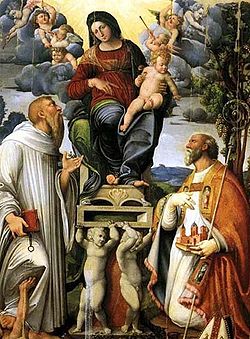
Reggio nell'Emilia, usually referred to as Reggio Emilia, or simply Reggio by its inhabitants, and known until 1861 as Reggio di Lombardia, is a city in northern Italy, in the Emilia-Romagna region. It has about 171,944 inhabitants and is the main comune (municipality) of the province of Reggio Emilia.
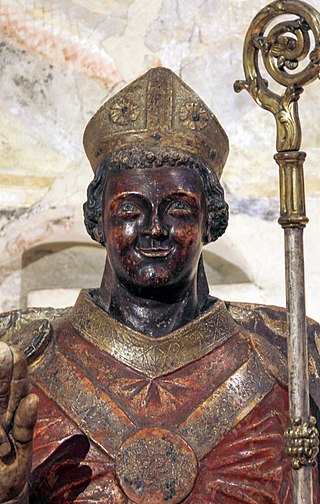
Zeno of Verona was an Afro-Italian Christian figure believed to have either served as Bishop of Verona or died as a martyr. He is venerated as a saint in the Catholic Church and the Orthodox Church.

Victor the Moor was a native of Mauretania and a Christian martyr, according to tradition, and is venerated as a saint.

Saint Renatus is the name of a French and an Italian saint of the Catholic Church who is claimed to be the same person. There are different stories of two saints with by the name Renatus, who were later merged into a single one based on their described similarities and contemporaneity. Both are venerated in Italy and France. They were: Saint Renatus of Sorrento, and Saint Renatus of Angers. Part of their stories seem to be a legend, part incomplete and part deficient historically documented.
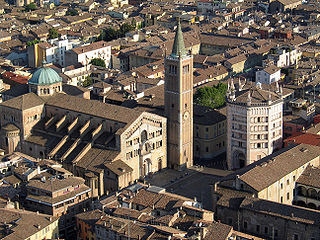
Parma Cathedral is a Roman Catholic cathedral in Parma, Emilia-Romagna (Italy), dedicated to the Assumption of the Blessed Virgin Mary. It is the episcopal seat of the Diocese of Parma. It is an important Italian Romanesque cathedral: the dome, in particular, is decorated by a highly influential illusionistic fresco by Renaissance painter Antonio da Correggio.
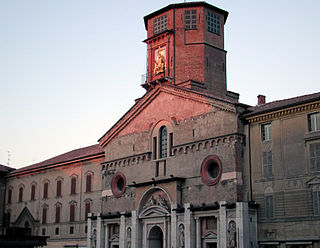
Reggio Emilia Cathedral is a Roman Catholic cathedral in Reggio Emilia. The dedication is to the Assumption of the Virgin Mary. Formerly the episcopal seat of the Diocese of Reggio Emilia, it has been since 1986 that of the Diocese of Reggio Emilia-Guastalla.
Saint Venerius was a monk and hermit. He is venerated as a saint by the Catholic Church and is the patron saint of the Gulf of La Spezia and, as of 1961, the patron saint of lighthouse keepers. Traditions concerning him are very uncertain.
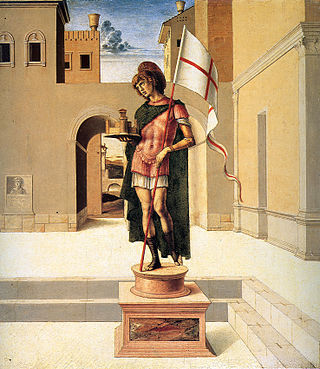
Saint Terence is the patron saint of Pesaro. According to tradition, he was from Pannonia and fled to the Adriatic coast to escape the persecution of Christians under Decius. His corpse was eventually thrown into a gorge near some hot springs, near Pesaro. The place of his martyrdom was considered to be the area called the Apsella di Montelabbate, near the Abbey of San Tomaso in Foglia. This area contains sulphurous springs, and locally they are called the l'Acqua di S. Terenzio.

The Diocese of Reggio Emilia–Guastalla is a Latin diocese of the Catholic Church in Emilia-Romagna, Italy. It has existed in its current form since 1986. In that year the historical Diocese of Reggio Emilia was united with the Diocese of Guastalla. The diocese is a suffragan of the Archdiocese of Modena–Nonantola.
Saint Flavian of Ricina is venerated as a martyr and bishop by the Catholic Church. Tradition holds that he was a bishop of Helvia Ricina (Macerata), during the 3rd century, martyred on November 24. His cult is ancient and widespread in the Marche and Umbria, with many churches and abbeys dedicated to him, but historical information on his life is limited to a few details and traditions.

Eleutherius, also written as Eleutherus, Eleuterus and Eleftherios; sometimes called Liberalis or Liberator Greek: Ἐλευθέριος) and his mother Antia, or Anthia are venerated as Christian saints and martyrs in Greece and Italy.
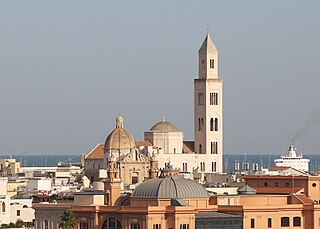
Bari Cathedral, or Cathedral of Saint Sabinus, is the cathedral of Bari, in Apulia, southern Italy. The cathedral is the seat of the Archbishop of Bari-Bitonto, as it was previously of the archbishops, earlier bishops, of Bari. It is dedicated to Saint Sabinus, a bishop of Canosa, whose relics were brought here in the 9th century. It is senior to, though less famous than, Apulia's Basilica of St Nicholas.
Pontianus was a second century Christian martyr. He was martyred during the reign of the Emperor Marcus Aurelius. He is honored as a saint and martyr by the Catholic Church, the Old Catholic Church, and the Eastern Orthodox Church. In Spoleto, Italy, he is invoked for protection against earthquakes.
Saint Libertine is venerated as a Christian martyr and as the first bishop of Agrigento, in Sicily.

The Basilica of Saint Marinus is a Catholic church located in the Republic of San Marino. While the country has a distinct domination of historic religious buildings of Christian faith, the basilica is the main church of the City of San Marino. It is situated on Piazzale Domus Plebis on the northeastern edge of the city, adjacent to the Church of Saint Peter. It is dedicated to Saint Marinus, the founder and patron of the Republic.

Saint Titian of Oderzo was a 7th-century bishop of Opitergium (Oderzo), in the Province of Treviso.

The Basilica of San Prospero is a Renaissance-style, Roman Catholic church with a late Baroque-style facade, located on Piazza di San Prospero in central Reggio Emilia, Italy.
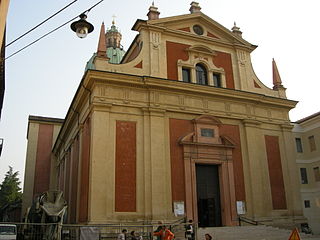
San Pietro is a Baroque style, Roman Catholic church located on Via Campo Samarotto #1, with a facade along Via Emilia San Pietro, in the southwestern sector of central Reggio Emilia, Italy.
Anselmo Govi was an Italian painter and decorator, a member of the late Art Nouveau school known in Italy as Liberty style.

Priscus of Nocera was the first bishop of Nocera, patron saint of the city of Nocera Inferiore and of the diocese of Nocera Inferiore-Sarno.
